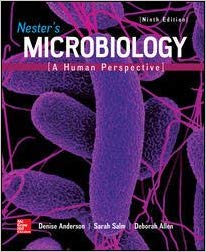Description
Test Bank For Inquiry Into Life 15Th Edition By Sylvia Mader
Chapter 03
Cell Structure and Function
Multiple Choice Questions
1. Which of the following is not true concerning the cell theory?
A. Virchow asserted that all cells come from preexisting cells.
B. Schleiden determined that all plants are made of cells.
C. Schwann researched animal tissues and discovered that they were all made of cells.
D. Hooke observed the cells of cork.
E. Leeuwenhoek first used the term “cells.”
All of the statements are true except Hooke, not Leeuwenhoek, was the first to use the term “cells” because the tiny chambers he observed in cork reminded him of the rooms, or cells, in a monastery.
Bloom’s Level: 1. Remember
Learning Outcome: 03.01.02 List the basic principles of the cell theory.
Section: 03.01
Topic: Cell Theory
2. According to cell theory
A. all organisms are composed of tissues.
B. the smallest unit of life is a nucleus.
C. animals but not plants are composed of cells.
D. a multicellular organism is composed of many cells.
E. new cells arise only from preexisting cells.
Cell theory states that all organisms are made up of basic living units called cells, and that all cells come only from previously existing cells. While multicellular organisms are composed of many cells, this is not part of cell theory. Some organisms are single celled, the smallest unit of life is a cell, and both animals and plants are composed of cells.
Bloom’s Level: 1. Remember
Learning Outcome: 03.01.02 List the basic principles of the cell theory.
Section: 03.01
Topic: Cell Theory
3. The body of a slime mold that flows over a rotten log appears to lack any partitioning into distinct cells; however it does become cellular when it changes form and produces spores. The surfaces of parasitic flatworms and some insect tissues are “syncytial” layers of living material that developed from a single cell but now contains many nuclei but lack partitioning by cell membranes. These tissues actively consume food and produce wastes. Considering that the cell theory states that “all living things are composed of cells,” then
A. these tissues are not living because they violate the cell theory.
B. this proves some vital force is involved beyond normal cell structures in order to give life to living organisms.
C. these tissues are obviously a bridge between nonliving and primitive living cells.
D. the general concept of life-is-cellular still holds since sometime in their life these organisms still utilize cells, but this shows cell membranes can be abandoned.
E. this demonstrates that cell membranes are a necessity to be classified as a living cell.
These organisms are living and were once composed of cells, even if the internal membranes between cells have been done away with. Since these organisms exhibit other characteristics of living cells, they are not nonliving, nor do they do not form a bridge between nonliving and living. Since they were once cells, no other vital force needs to be implicated. Since these cells do not have complete cell membranes, cell membranes are not a necessity to be classified as living.
Bloom’s Level: 5. Evaluate
Learning Outcome: 03.01.01 Explain why cells are the basic unit of life.
Section: 03.01
Topic: Cell Theory
4. The cell theory states
A. all organisms are composed of only one cell.
B. organelles are the basic living unit of structure and function of organisms.
C. all cells come only from other cells.
D. all organisms are composed of only one cell AND organelles are the basic living unit of structure and function of organisms.
E. all multicellular organisms are unicellular at some point in their life cycle.
Cell theory states that all organisms are made up of basic living units called cells, and that all cells come only from previously existing cells. Many living organisms are multicellular and cells, not organelles, are the basic living unit. Whereas all multicellular organisms may begin as a unicellular organism at some point in their life cycle, this is not part of cell theory.
Bloom’s Level: 1. Remember
Learning Outcome: 03.01.02 List the basic principles of the cell theory.
Section: 03.01
Topic: Cell Theory
5. Surface-area-to-volume ratios indicate
A. cells must exceed a certain minimum size.
B. as cells get larger, their surface area actually decreases.
C. that the largest cells have a less proportionate need for food intake and waste removal.
D. a chicken egg is one cell thus demonstrating the upper limit for metabolizing cell size.
E. as cells get larger, their surface area gets larger but at a slower rate than the volume increases.
As a cell increases in size, the volume increases by the cube of the sides, while the surface area increases by the square of the sides. Therefore, the surface area increases but at a slower rate than the volume increases. There is no minimum cell size and large cells still need surface area for food intake and waste removal. A chicken egg is one cell, but it is not actively metabolizing. It divides into many smaller cells before it begins to metabolize.
Bloom’s Level: 2. Understand
Learning Outcome: 03.01.03 Explain the difference between the surface-area-to-volume ratios for large and small cells.
Section: 03.01
Topic: Cell Theory
6. Compared with a eukaryotic cell, a prokaryotic cell
A. lacks organelles beyond ribosomes.
B. is larger.
C. does not require energy.
D. is not living.
E. has no method of movement.
A prokaryotic cell lacks membrane bounded organelles. It does have ribosomes. Prokaryotic cells are smaller than eukaryotic cells and do require energy. Prokaryotic cells are living and many have methods of movement.
Bloom’s Level: 1. Remember
Learning Outcome: 03.02.01 Describe the fundamental components of a bacterial cell.
Section: 03.02
Topic: Prokaryote Structure
7. Circulating red blood cells in your body do not contain a nucleus and other organelles. Are these cells living?
A. Yes, because they are actively metabolizing and once contained organelles.
B. Yes, because they are capable of moving throughout the body in the circulation.
C. No, because they do not contain a nucleus, they cannot be living.
D. No, because red blood cells do not actively metabolize.
E. No, because they are now only part of a once living cell.
Red blood cells are living because they actively metabolize. The organelles were lost in the maturation process and thus, red blood cells are fairly short lived. Red blood cells do move but that is not why they are considered living.
Bloom’s Level: 3. Apply
Learning Outcome: 03.03.02 Identify the cellular structures unique to both plant and animal cells.
Section: 03.03
Topic: Eukaryote Structure
8. An agent would make a good antibiotic if it affected a structure or process only found in bacterial cells and not in our (eukaryotic) cells. Which of the following actions would theoretically make a good antibiotic?
A. prevents repair of the peptidoglycan cell wall
B. damages the nuclear membrane
C. damages DNA
D. prevents ribosomes from producing proteins
E. stops cellular respiration
Only prokaryotic cells have a peptidoglycan cell wall. Both prokaryotic and eukaryotic cells have a nuclear membrane, DNA, ribosomes, and cellular respiration.
Bloom’s Level: 3. Apply
Learning Outcome: 03.02.01 Describe the fundamental components of a bacterial cell.
Section: 03.02
Topic: Prokaryote Structure
9. Which of the following is a prokaryotic cell?
A. plant cell
B. liver cell
C. muscle cell
D. paramecium
E. bacterium
Only a bacterium is a prokaryotic cell. Plants, animals (liver and muscle), and paramecia are all eukaryotes.
Bloom’s Level: 2. Understand
Learning Outcome: 03.02.02 Identify the key differences between the archaea and bacteria.
Section: 03.02
Topic: Prokaryote Structure





Be the first to review “Test Bank For Inquiry Into Life 15Th Edition By Sylvia Mader”